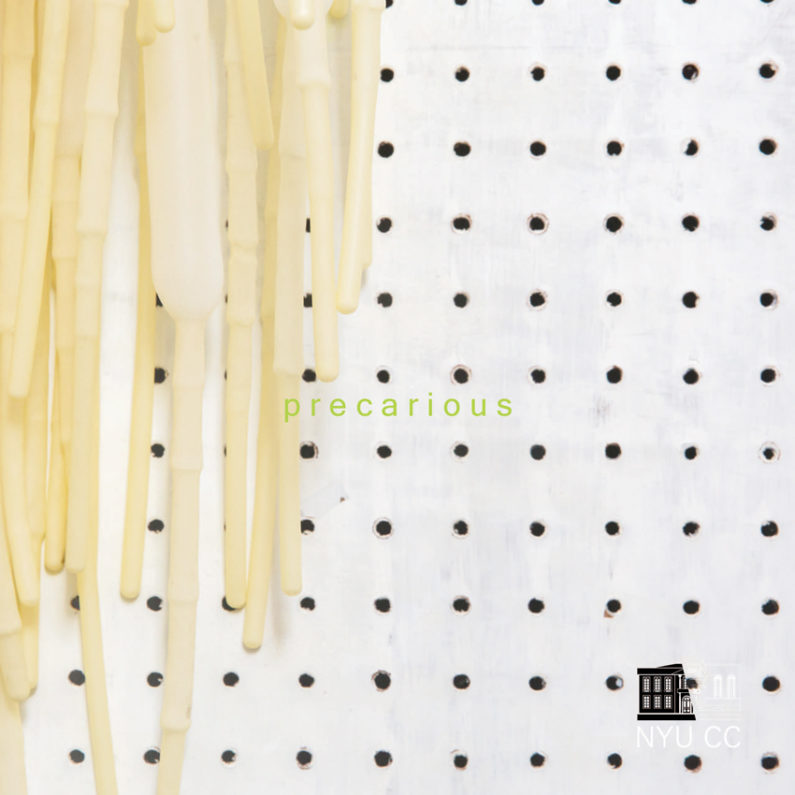Works by Jay S. Yoon, Shinan Wang, Maya Pollack, Bambou Gili, and Audrey Gascho
Curated by Samantha H. Rowe, Emily Rose Shoyer, and Chao Chi Chiu
Wednesday, January 24th, 5 pm – 8 pm
On view through February 10th, 2018
The Commons Gallery
34 Stuyvesant Street
The precarious is defined as that which is not securely held, likely to collapse, and generally uncertain. P r e c a r i o u s showcases works of art by artists Jay S. Yoon, Shinan Wang, Maya Pollack, Bambou Gili and Audrey Gascho, that examine variants of its namesake be they political, traumatic, or uncomfortable. The show’s core text is Judith Butler’s Precarious Life, in which she states, “I propose to consider a dimension of political life that has to do with our exposure to violence and our complicity in it, with our vulnerability to loss and the task of mourning that follows, and with finding a basis for community in these conditions.” Our very existence is perilous because we function within a frail construction of our own making. Divided into three sections: p r e c a r i o u s: systems, p r e c a r i o u s: humanism, and p r e c a r i o u s: intimacy, this exhibition features works that invite viewers to ruminate on perspectives that are too often occluded in a majoritarian society, inspiring them to construct new meanings of their own.
The preliminary section, p r e c a r i o u s: systems, addresses the unstable, oppressive and even violent nature of specific institutions within the social world. Gascho examines trauma both in relation to her own experience of assault and as an erosive historical constant. Her monotype prints, the extraordinary jubilee of mercy (2017), when in Rome (2017), and Untitled (basilica) (2017), delve into the fragility of Catholicism. Gascho’s interest in fragility continues in her video piece il ratto di proserpina (2018), as a reference to Gian Lorenzo Bernini’s sculpture The Rape of Proserpina (1621 – 22). In her modification of Bernini’s sculpture, Gascho eliminates the figure of Pluto, silencing the rapist in favor of emphasizing the experience of the victim. By recontextualizing the sculpture, Gascho criticizes how viewers disregard the trauma of rape central to Bernini’s work, focusing instead on its formal mastery. In Admissions (2017), Gascho redacts the content of a college admission letter in three different iterations, questioning recent controversies at universities regarding rape cases and violations of federal laws.
Through a gestural style of painting on unstretched canvases, Bambou Gili ridicules the oversexualized representations of women in Medieval imagery and recontextualizes them to fit humorously, or horrifically, in our contemporary moment. Squirt (2016) is a response to a recent headline in the Daily Mail that read, “Furious mother ‘squirted her boob’ at a woman who told her to move while she was breastfeeding because it was distracting her husband.” The work
highlights how women perpetuate our patriarchal system by categorizing other women by the Madonna or whore dialectic. Gili uses the same representational techniques in Untitled, Market (2016) and Untitled (2016). The juxtaposition of Gascho’s severe interrogations with Gili’s humorous exploitation of systemic instability creates an interesting contrast.
Pollack, a multimedia artist, explores how we perceive the “self” in the context of the “other.” In her silkscreen print Straight (2015), a woman in a back-brace stands starkly upright over a grid-like background, almost resembling a medical document due to the contraption on her fluorescent body, the mathematical grid resembling an x-ray. Yoon, who is interested in using sculpture to examine the relationship between technology and humans, questions our dependence upon the pharmaceutical industry through Happy Birthday (2017). In this sculpture, injection needles emerge out of Saizen® or somatropin, a growth hormone with possible lethal side effects used on children. In “Subject and Power” Michel Foucault explains, “the medical profession is not criticized primarily because it is a profit-making concern but because it exercises an uncontrolled power over people’s bodies.” Both Pollack and Yoon challenge spectators to question this dependence upon the medical industry, as a system that dominates over life and death.
Perplexingly, our relationship with social systems is insecure despite the fact that humans construct these systems. How should we perceive our role in the natural world; a “system” not of our creation, but one that we are born within? P r e c a r i o u s: humanism aims to mediate this question.
In Untitled (Projection) (2017), Pollack accentuates our morbid curiosities, particularly about species we do not tend to empathize with. The installation invites spectators to enter an uncanny space where they are surrounded, through the use of mirror reflection, by a video projection of a squirming carp that is captured and photographed from a fishing trip. Through this installation, Pollack conjures feelings of empathy and alienation, emphasizing the slippery state of flux between these emotions.
This sense of detachment from nature has been augmented in today’s rapidly modernizing world. Yoon’s ПРОЕКТ НЕО-ХЕРУВИМ (Project Neo-Cherubim) (2017) is a totem of technological process: a robot figure accompanied by the music, “Hymn of Cherubim” standing beside amidst soil and plants. Inside it, a hydraulic system filters contaminated water for safe use. The sculpture exemplifies the conundrum that we desire technological progress, yet possess a fear of its unknowability. The soil and plants remind the viewer of the natural world, while the robot’s imposing figure, calling to mind neoclassical statues, represents the monumentality of technology. Through this visual dialectic, Yoon queries for a compromise between these poles.
Yoon also emphasizes our anxieties in Robophobia (2017), in which a robotic arm personifying a puppeteer seeks to manipulate the actions of a red doll, imitating our own vulnerability in the face of the possible prowess of the technology we create.
While Yoon’s work questions the future, Wang’s embraces tradition through her ceramic sculptures. Natural Beauty (2017) features a series of polished feminine busts wearing scarred antlers, criticizing how modern capitalism removes creatures from their natural environments to violently become objects of consumption.
Horror and Discourse: Gun Violence in America (2017) is a direct response to the recent shootings in downtown Manhattan. A fox carcass is suspended from the ceiling captured in the instant it was shot. Wang mobilizes the work’s shock value to confront her viewers and showcase how we become accustomed to violence.
While Wang’s work explores the physicality of violence, Gascho exposes the psychological impact of human violence. Yellow (2018) is a physical installation of monotype prints, words on wood panels, and small sculptures that the artist has been working on and collecting for months. The installation is an account of Gascho’s personal trauma. Through
dissociation, her assemblage creates a harrowing display of objects and images that were directly linked to the location of her assault. The title of this installation relates to Coldplay’s song “Yellow,” which played while the incident took place. Yellow reveals the scars latent within her subconscious, conveying the unreliability of painful memories.
Related to our understanding of human nature and the environment we reside in, is the community we choose to join. We assume that all communities and relationships are formed to promote good, but what if they are not? P r e c a r i o u s: intimacy explores such notions.
Gascho explores this motif by revealing the limitations of a community in without dismissal (2017). She underlines a community’s fallibility by utilizing a pegboard and recreational party balloons to question the validity of the support system. As the balloons deflate over time, it exposes the compromised state of this defective system.
Pollack further articulates this tension in Untitled (Blinds) (2016) as boundaries are never clearly defined. Window blinds permit humans to decide whether to expose or conceal themselves to those around them. Pollack’s sculpture is intentionally unstable to emphasize the uncertainties still extant even after the construction of physical boundaries like blinds.
Wang’s The lover asks forgiveness because of his many moods (2016) centers on the disquietude of relationships. Displayed as a pair, the inanimate objects are interpreted as ‘Lovers’. Insecurely positioned on their pedestal’s edge, the bottles cause the spectator to consider their fate. Wang’s anxiety-provoking lovers mimic our constant state of fragility in a relationship. We sacrifice our sense of emotional security for the joys of intimacy. Similarly, Gili illustrates relationships’ anxiety in her painting Blue Jungle (2017). With two isolated figures surrounded by a dark and turbulent composition, so solitary that one can assume them to be the last two individuals on earth, Gili pokes fun at contemporary dating where people pair up due to their fears of being alone. The work exposes this societal detachment from real romance through a simultaneous sense of satire and real incoming danger.
The final section of the exhibition imparts an understanding of the instability of our most intimate moments. The p r e c a r i o u s nature of our existence seems inconclusive in that it engenders more questions than answers. However, the artists exhibited use this inconclusivity productively by empowering the viewer to ask essential questions about life’s uncertainties.
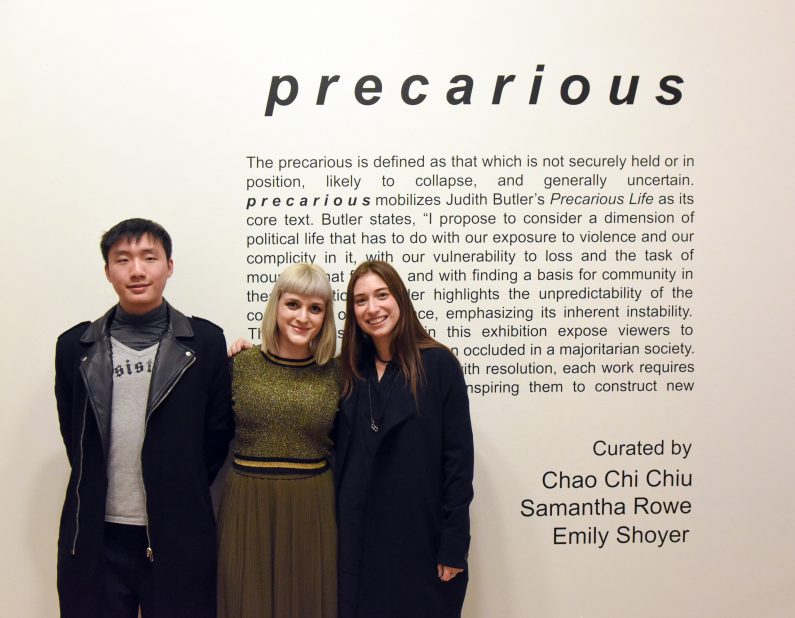
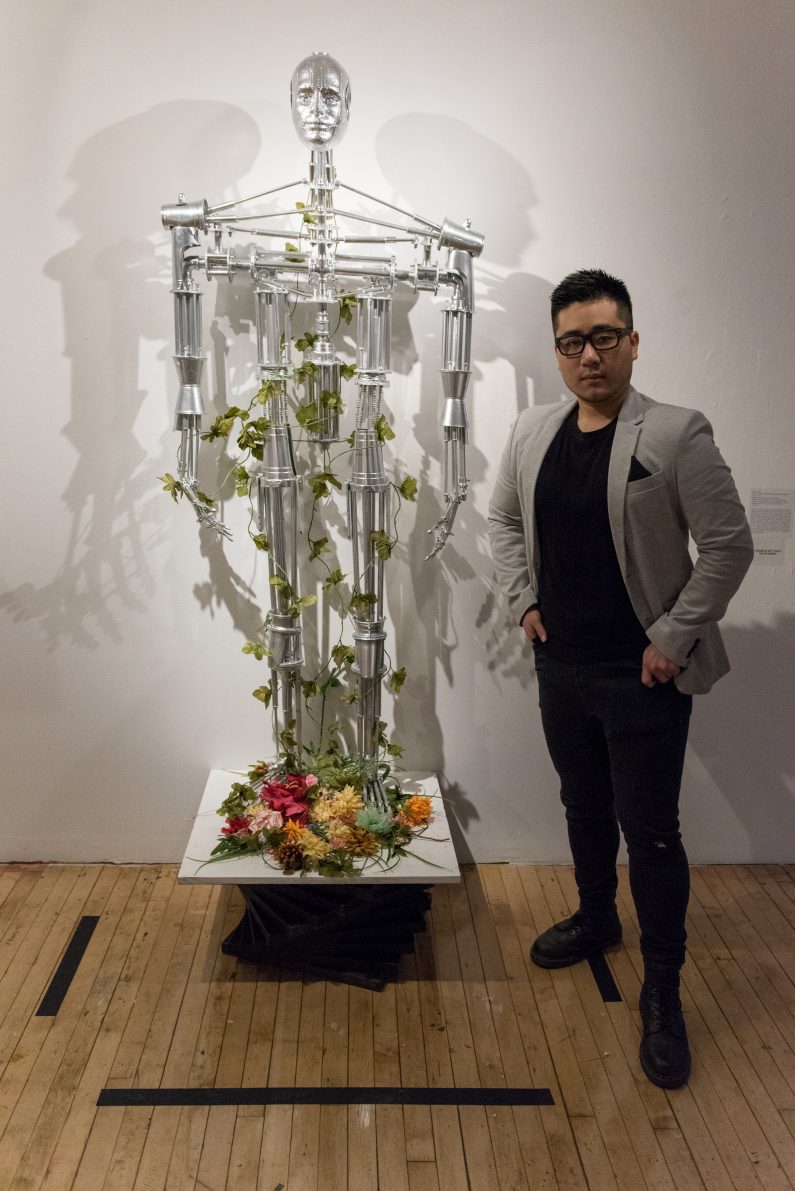
Galvanised steel, aluminium, titanium, ABS and PVC plastics, thermal coating, titanium chrome coating, wood, wire, metal rods, carbon plastic styrofoam, hardboard, couples, turings, pipes, PVC tubes, and metal filters.
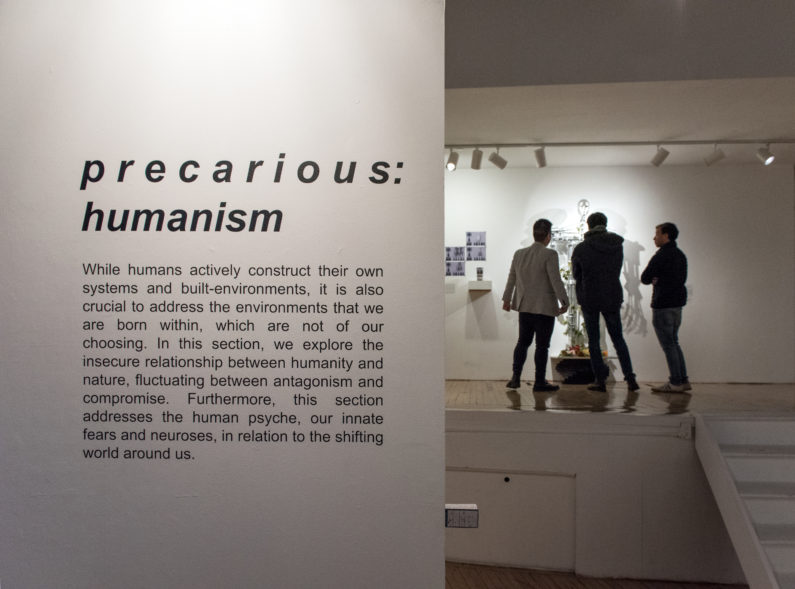
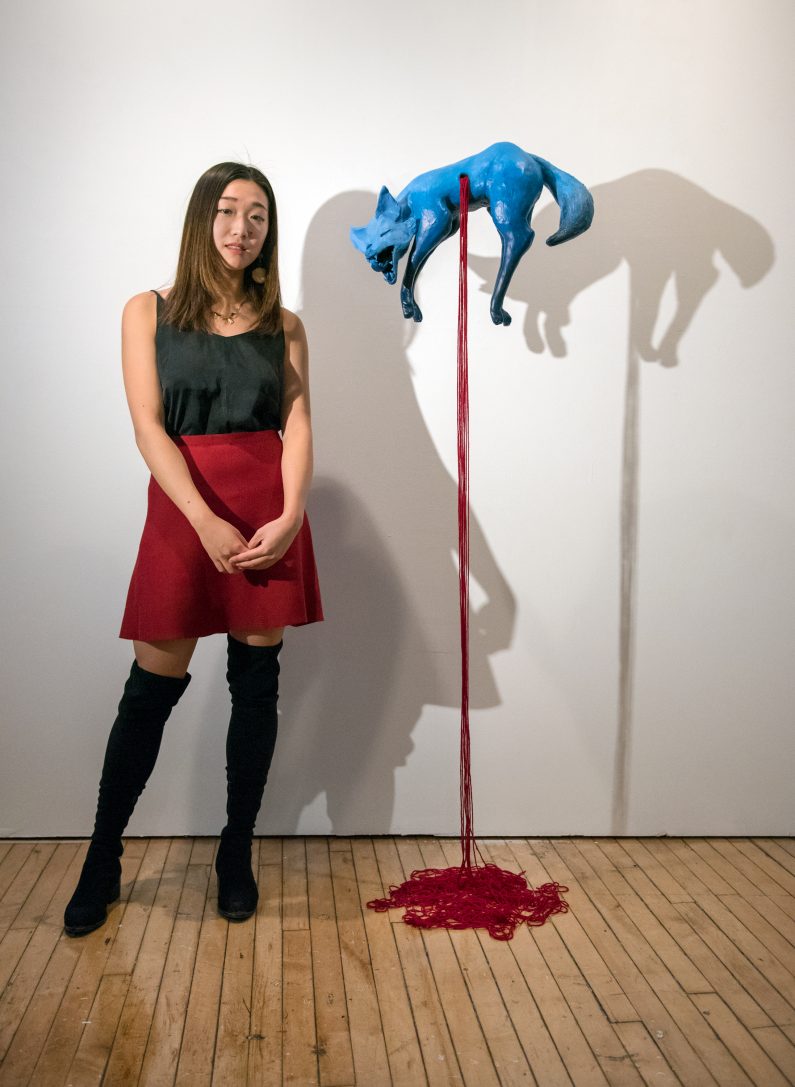
Ceramics, woolen yarn, 20 x 30 x 12 in.
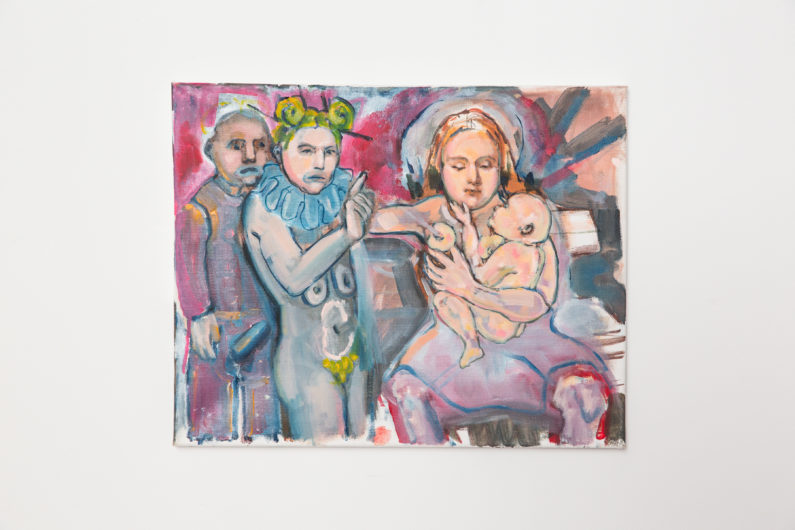
Oil on Canvas, 18 x 24 inches.
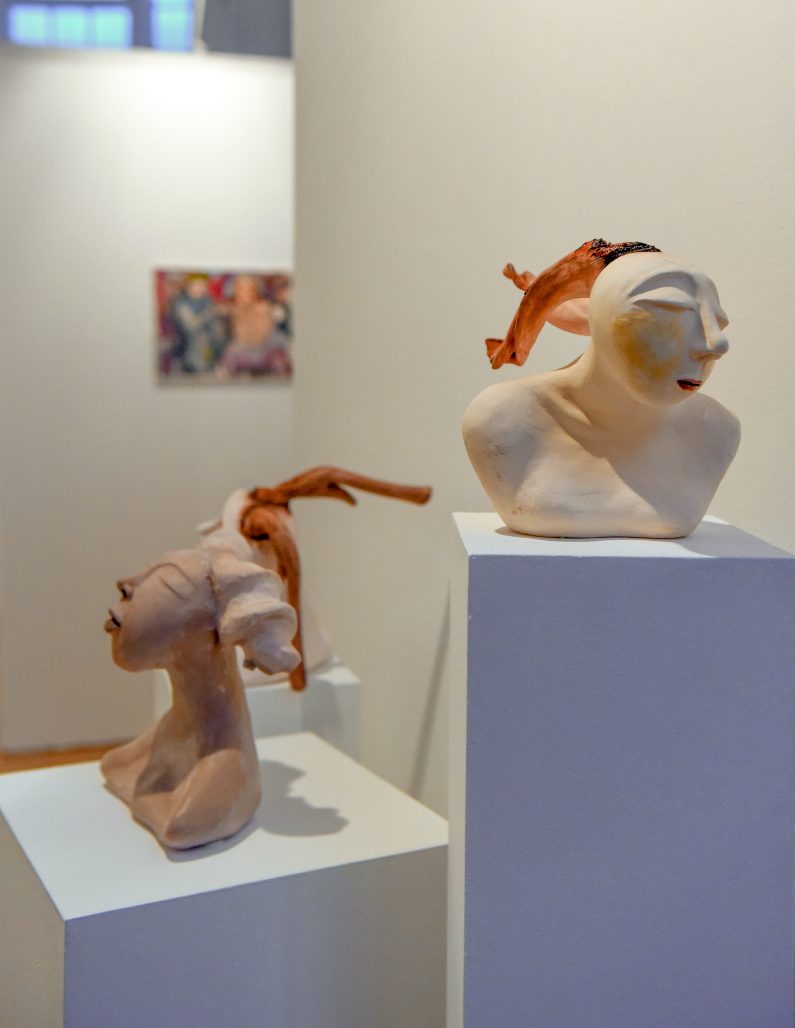
Ceramic, 10 x 12 x 6 inches.
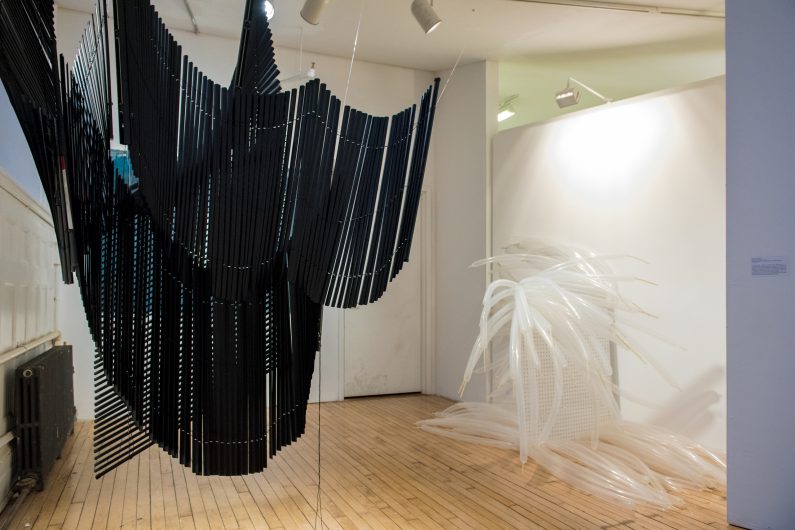
Blinds and string, dimensions variable.
Right: Audrey Gascho, “without dismissal”, 2017
Wooden pegboard, white paint, latex balloons, 47 x 26 inches.
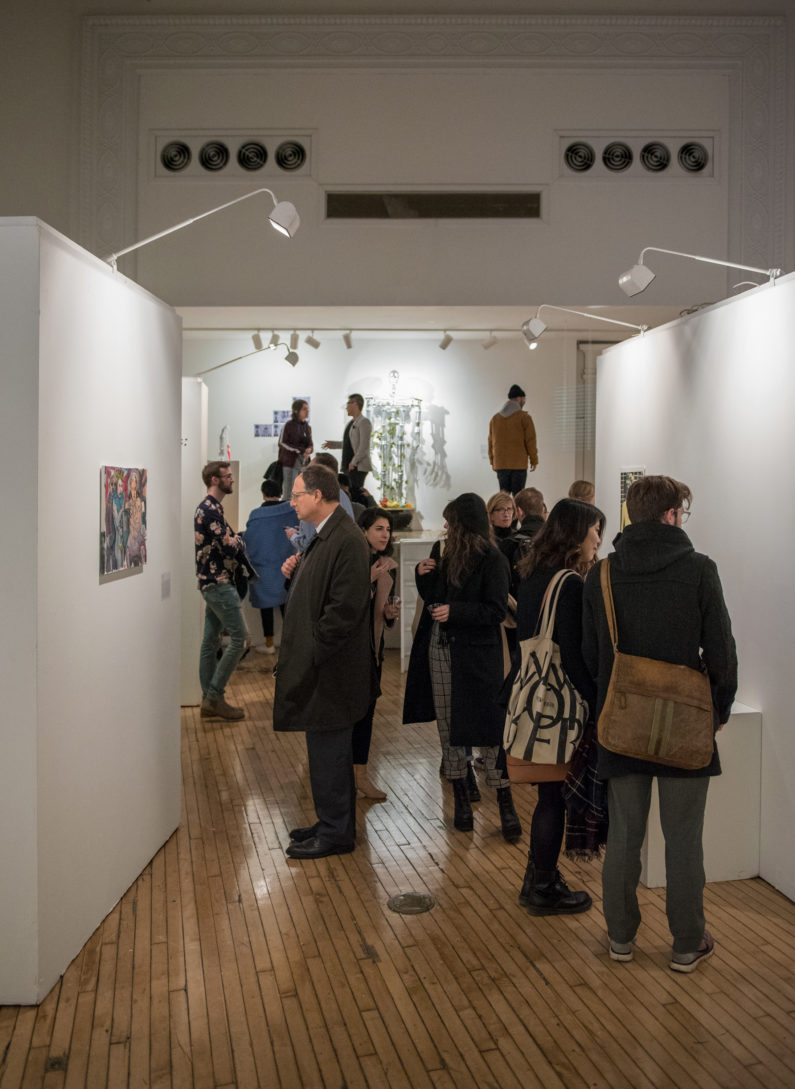
Photos by A. Leonardo Amiri
